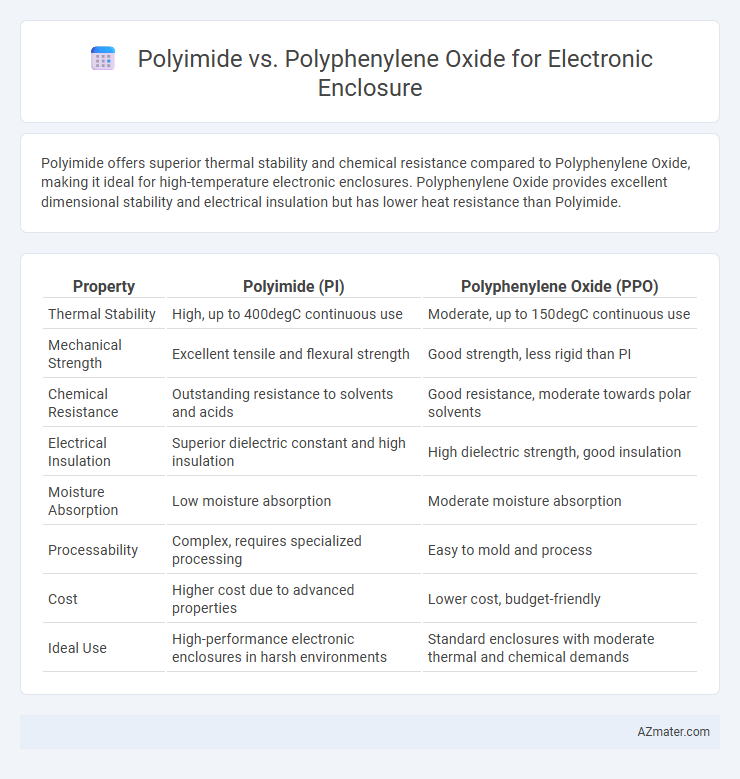Polyimide offers superior thermal stability and chemical resistance compared to Polyphenylene Oxide, making it ideal for high-temperature electronic enclosures. Polyphenylene Oxide provides excellent dimensional stability and electrical insulation but has lower heat resistance than Polyimide.
Table of Comparison
| Property | Polyimide (PI) | Polyphenylene Oxide (PPO) |
|---|---|---|
| Thermal Stability | High, up to 400degC continuous use | Moderate, up to 150degC continuous use |
| Mechanical Strength | Excellent tensile and flexural strength | Good strength, less rigid than PI |
| Chemical Resistance | Outstanding resistance to solvents and acids | Good resistance, moderate towards polar solvents |
| Electrical Insulation | Superior dielectric constant and high insulation | High dielectric strength, good insulation |
| Moisture Absorption | Low moisture absorption | Moderate moisture absorption |
| Processability | Complex, requires specialized processing | Easy to mold and process |
| Cost | Higher cost due to advanced properties | Lower cost, budget-friendly |
| Ideal Use | High-performance electronic enclosures in harsh environments | Standard enclosures with moderate thermal and chemical demands |
Introduction to Electronic Enclosure Materials
Polyimide and polyphenylene oxide are prominent materials used for electronic enclosures due to their exceptional thermal stability and electrical insulation properties. Polyimide offers superior heat resistance up to 400degC, making it ideal for high-temperature electronic applications, while polyphenylene oxide provides excellent dimensional stability and moisture resistance. Selecting the appropriate material depends on the specific environmental conditions and mechanical demands of the electronic device enclosure.
Overview of Polyimide and Polyphenylene Oxide
Polyimide offers exceptional thermal stability, mechanical strength, and chemical resistance, making it ideal for harsh electronic enclosure environments requiring durability and high-performance insulation. Polyphenylene Oxide provides excellent electrical insulation, dimensional stability, and moisture resistance, suited for electronic housings demanding precision and sustained electrical integrity. Both materials serve crucial roles in electronics, with polyimide favored for extreme conditions and polyphenylene oxide preferred for lightweight, cost-effective enclosures.
Mechanical Strength Comparison
Polyimide exhibits superior mechanical strength compared to polyphenylene oxide, offering higher tensile strength and excellent impact resistance, making it ideal for electronic enclosures that demand durability and structural integrity. Polyimide also maintains mechanical stability under extreme temperatures and harsh environments, whereas polyphenylene oxide, while resistant to thermal degradation, tends to have lower impact resistance and tensile modulus. Selecting polyimide enhances reliability and longevity in electronic device protection against mechanical stress and environmental factors.
Thermal Stability and Heat Resistance
Polyimide exhibits superior thermal stability with a decomposition temperature often exceeding 500degC, making it ideal for electronic enclosures exposed to extreme heat. Polyphenylene oxide (PPO) offers good heat resistance up to approximately 200-260degC but falls short compared to polyimide in high-temperature environments. The high glass transition temperature (Tg) of polyimide enhances its durability and mechanical integrity under sustained thermal stress, outperforming PPO for advanced electronic applications.
Electrical Insulation Properties
Polyimide offers superior electrical insulation properties with a high dielectric strength of up to 300 kV/mm, making it ideal for electronic enclosures requiring robust protection against electrical currents. Polyphenylene oxide exhibits good electrical insulation with dielectric constants typically around 2.7, but its performance at higher temperatures is lower compared to polyimide. The choice between polyimide and polyphenylene oxide depends largely on the operating temperature range and the electrical insulation demands of the electronic application.
Chemical Resistance and Environmental Suitability
Polyimide offers exceptional chemical resistance to solvents, acids, and bases, making it highly suitable for harsh chemical environments in electronic enclosures. Polyphenylene oxide provides good resistance to moisture and some chemicals but tends to degrade faster under strong acidic or alkaline conditions compared to polyimide. Both materials exhibit strong thermal stability, but polyimide's superior chemical resistance and durability make it more environmentally suitable for long-term exposure in aggressive industrial settings.
Flame Retardancy and Safety Features
Polyimide exhibits superior flame retardancy with a high limiting oxygen index (LOI) above 40%, making it inherently self-extinguishing and ideal for stringent electronic enclosure safety standards. Polyphenylene oxide (PPO) offers good thermal stability but typically requires flame retardant additives to meet UL94 V-0 ratings, potentially introducing halogenated compounds. For mission-critical electronics, polyimide's robust thermal resistance and low smoke emission deliver enhanced fire safety and regulatory compliance over PPO-based materials.
Machinability and Fabrication Techniques
Polyimide offers superior thermal stability and chemical resistance, making it ideal for high-performance electronic enclosures, but it requires specialized machining techniques such as laser cutting or CNC milling due to its toughness and tendency to delaminate. Polyphenylene oxide (PPO) provides easier machinability with conventional methods like drilling, sawing, and milling, supported by its lower melting point and dimensional stability. Fabrication of polyimide often involves precision processes to maintain integrity, while PPO enables more cost-effective and rapid production for standard electronic housing applications.
Cost Analysis and Market Availability
Polyimide offers superior thermal stability and chemical resistance for electronic enclosures but typically comes at a higher cost compared to polyphenylene oxide (PPO), which provides good electrical insulation and moderate heat resistance at a more economical price point. Market availability favors PPO due to its widespread use in consumer electronics, leading to readily accessible supply chains and cost-efficient manufacturing. Cost analysis reveals that while polyimide's premium material expense suits high-performance applications, PPO's balance of affordability and adequate properties makes it the preferred choice for mass-produced enclosures.
Application Suitability and Industry Use Cases
Polyimide exhibits exceptional thermal stability and chemical resistance, making it ideal for high-performance electronic enclosures in aerospace and automotive industries where extreme conditions are prevalent. Polyphenylene oxide offers excellent electrical insulation, dimensional stability, and moisture resistance, widely used in consumer electronics and telecommunications for housing sensitive components. Application suitability depends on operating temperature thresholds and environmental exposure, with polyimide favored for harsh settings and polyphenylene oxide for cost-effective, durable electronic casings.

Infographic: Polyimide vs Polyphenylene Oxide for Electronic Enclosure
 azmater.com
azmater.com